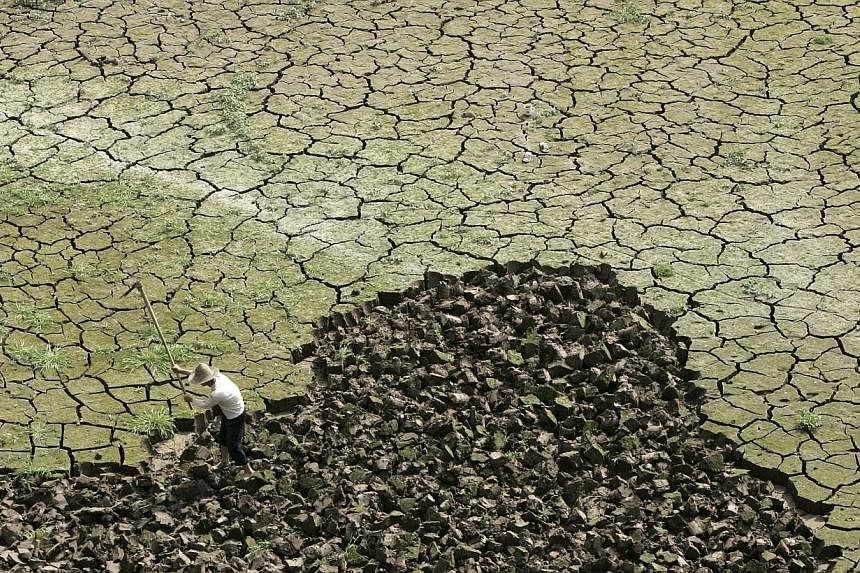Three of the big meteorological agencies on the Pacific Rim now agree that the El Nino weather phenomenon - which can spark deadly and costly climate extremes - is back, and will pack a punch this year.
The Australian Bureau of Meteorology, United States Climate Prediction Centre and Japan Meteorological Agency on Tuesday all declared, from checking sea-surface temperatures and reactions in the atmosphere above the Pacific Ocean, that the tropical Pacific is in the early stages of the pattern.
Here's a look at what the return of El Nino means:
1. What is El Nino?
Its name means "the little boy" in Spanish, and occurs when the trade winds that circulate over waters in the tropical Pacific start to weaken and sea surface temperatures rise, causing heavy rains and floods in South America and scorching weather in Asia and even east Africa.
The last El Nino was from 2009 to 2010. The Pacific region has either been in its cooler state called La Nina or neutral since then.
2. What possible impact will it have?
El Nino is responsible for a whole array of natural disasters, from droughts to flooding. The 2010 El Nino had a major impact, with monsoons in South-east Asia, droughts in southern Australia, the Philippines and Ecuador, blizzards in the United States, heatwaves in Brazil and killer floods in Mexico.
This year's pattern could create drier conditions in Indonesia, Papua New Guinea and parts of South-east Asia.
Droughts in parts of Asia and Australia can ravage croplands and drive food prices to multi-year highs, causing havoc for farmers and global agricultural markets and hitting economies heavily dependent on the land.
The pattern can crimp the hurricane season in the Atlantic, bring heavy rain and floods in South America that kills hundreds and costs billions in damage. It can also bring more rain across the southern US and warm some northern states.
In 1982-1983, El Nino set off a series of droughts, wildfires and flooding from South America to Australia that cost US$8 billion and killed almost 2,000 people, according to the National Oceanic and Atmospheric Administration.
The agency estimated the US economic cost of the 1997-1998 El Nino at US$10 billion, with crops wilting or drowning in the fields and consumers spending US$2.2 billion less on heating fuels.
3. Which crops will be affected?
Palm oil, cocoa, coffee and sugar are the crops most at risk, according to Goldman Sachs Group last year.
Palm oil futures climbed as much as 1.6 per cent in Kuala Lumpur on concern that dry weather spurred by El Nino would curb yields in Indonesia and Malaysia, which account for 86 per cent of world supplies. Indonesian production dropped 7.1 per cent and Malaysian output fell 5.5 per cent at the time of the last strong El Nino in 1997-1998, US Agriculture Department data shows.
Some other crops that may be affected are Australia's high-protein wheat crop, likely to take a hit from the dry weather heralded by El Nino to affecting the all-important September period for the crop.
Rice, Asia's staple food, requires rains in July and August. A drought would provide a floor under rice prices. A rally in rice has the potential of stoking inflationary fears and unrest in the region.
Soybean production in India, and corn production in India and China are also at risk. If El Nino brings dry weather to the western and central regions of India, this could prompt it to import more palm oil and spur further potential gains in prices of the tropical oil. Soybeans are planted in June-July and the crop needs rains in August-September. Corn yields may be curbed as the crop needs relatively higher volumes of water.
4. What are some countries that will be affected?
El Nino increases the risk of drought in Australia. Of the 26 events since 1900, 17 have resulted in widespread drought, the Australian Bureau of Meteorology said. Farmers in eastern Australia will be keeping an eye on the forecast with planting of winter crops including wheat, barley and canola under way.
The monsoon in India, the world's second-biggest producer of sugar and wheat, may be below normal for a second year as the event develops, according to Harsh Vardhan, the country's minister of science and technology and earth sciences.
El Nino also raises the odds for a cooler US summer, and raises the possibilities for more hurricanes in the eastern Pacific and typhoons to the west.
El Nino is also causing dryness in the Philippines, Oil World, a Hamburg-based researcher, said this month.
The pattern can crimp the hurricane season in the Atlantic, bring more rain across the southern US and warm some northern states. It heralds a drier winter and spring in Australia's east.
5. How long will it last?
The Japan Meteorological Agency has forecast that it would continue into late 2015, but there is no consensus between the three agencies over how long it will last, as they each have their own criteria for the phenomena. Commercial forecasters also have their own opinions, which also diverge.
The US Climate Prediction Centre said there is a 70 per cent chance the pattern will continue through the Northern Hemisphere summer.
And the Australian weather bureau said: "We know that once an El Nino event's established, it's very likely to last through to the end of the year."

Sources: Agence France-Presse, Bloomberg, Reuters

